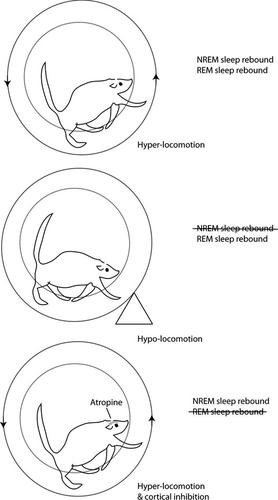当前位置:
X-MOL 学术
›
Eur. J. Neurosci.
›
论文详情
Our official English website, www.x-mol.net, welcomes your
feedback! (Note: you will need to create a separate account there.)
Roles of motor and cortical activity in sleep rebound in rat
European Journal of Neuroscience ( IF 2.7 ) Pub Date : 2020-06-25 , DOI: 10.1111/ejn.14881 Yujun Wen 1, 2 , Yudan Lv 1, 3 , Jianguo Niu 1, 2 , Christopher Xin 1 , Li Cui 3 , Ramalingam Vetrivelan 1 , Jun Lu 1
European Journal of Neuroscience ( IF 2.7 ) Pub Date : 2020-06-25 , DOI: 10.1111/ejn.14881 Yujun Wen 1, 2 , Yudan Lv 1, 3 , Jianguo Niu 1, 2 , Christopher Xin 1 , Li Cui 3 , Ramalingam Vetrivelan 1 , Jun Lu 1
Affiliation

|
Sleep pressure that builds up gradually during the extended wakefulness results in sleep rebound. Several lines of evidence, however, suggest that wake per se may not be sufficient to drive sleep rebound and that rapid eye movement (REM) and non‐rapid eye movement (NREM) sleep rebound may be differentially regulated. In this study, we investigated the relative contribution of brain versus physical activities in REM and NREM sleep rebound by four sets of experiments. First, we forced locomotion in rats in a rotating wheel for 4 hr and examined subsequent sleep rebound. Second, we exposed the rats lacking homeostatic sleep response after prolonged quiet wakefulness and arousal brain activity induced by chemoactivation of parabrachial nucleus to the same rotating wheel paradigm and tested if physical activity could rescue the sleep homeostasis. Third, we varied motor activity levels while concurrently inhibiting the cortical activity by administering ketamine or xylazine (motor inhibitor), or ketamine + xylazine mixture and investigated if motor activity in the absence of activated cortex can cause NREM sleep rebound. Fourth and finally, we manipulated cortical activity by administering ketamine (that induced active wakefulness and waking brain) alone or in combination with atropine (that selectively inhibits the cortex) and studied if cortical inhibition irrespective of motor activity levels can block REM sleep rebound. Our results demonstrate that motor activity but not cortical activity determines NREM sleep rebound whereas cortical activity but not motor activity determines REM sleep rebound.
中文翻译:

运动和皮质活动在大鼠睡眠反弹中的作用
在长时间的清醒过程中逐渐建立的睡眠压力会导致睡眠反弹。然而,有几条证据表明,唤醒本身可能不足以驱动睡眠反弹,并且快速眼动(REM)和非快速眼动(NREM)睡眠反弹可能受到不同的调节。在这项研究中,我们通过四组实验研究了大脑相对于体育活动对REM和NREM睡眠反弹的相对贡献。首先,我们强迫大鼠在转轮中运动4小时,然后检查随后的睡眠反弹。第二,我们暴露了由于臂臂旁核的化学激活在相同旋转轮范式下长时间安静的清醒和唤醒脑活动后缺乏稳态睡眠反应的大鼠,并测试了体育锻炼是否可以挽救睡眠稳态。第三,我们通过施用氯胺酮或甲苯噻嗪(运动抑制剂)或氯胺酮+甲苯噻嗪混合物来改变运动活动水平,同时抑制皮层活动,并研究在缺乏活化皮质的情况下运动活动是否会引起NREM睡眠反弹。第四也是最后,我们通过单独或与阿托品(可选择性抑制皮质)组合使用氯胺酮(可诱导活跃的清醒和醒来的大脑)来控制皮质活性,并研究不论运动水平如何,皮质抑制是否均可阻止REM睡眠反弹。我们的结果表明,运动活动而非皮质活动决定了NREM睡眠反弹,而皮质活动而非运动活动决定了REM睡眠反弹。
更新日期:2020-06-25
中文翻译:

运动和皮质活动在大鼠睡眠反弹中的作用
在长时间的清醒过程中逐渐建立的睡眠压力会导致睡眠反弹。然而,有几条证据表明,唤醒本身可能不足以驱动睡眠反弹,并且快速眼动(REM)和非快速眼动(NREM)睡眠反弹可能受到不同的调节。在这项研究中,我们通过四组实验研究了大脑相对于体育活动对REM和NREM睡眠反弹的相对贡献。首先,我们强迫大鼠在转轮中运动4小时,然后检查随后的睡眠反弹。第二,我们暴露了由于臂臂旁核的化学激活在相同旋转轮范式下长时间安静的清醒和唤醒脑活动后缺乏稳态睡眠反应的大鼠,并测试了体育锻炼是否可以挽救睡眠稳态。第三,我们通过施用氯胺酮或甲苯噻嗪(运动抑制剂)或氯胺酮+甲苯噻嗪混合物来改变运动活动水平,同时抑制皮层活动,并研究在缺乏活化皮质的情况下运动活动是否会引起NREM睡眠反弹。第四也是最后,我们通过单独或与阿托品(可选择性抑制皮质)组合使用氯胺酮(可诱导活跃的清醒和醒来的大脑)来控制皮质活性,并研究不论运动水平如何,皮质抑制是否均可阻止REM睡眠反弹。我们的结果表明,运动活动而非皮质活动决定了NREM睡眠反弹,而皮质活动而非运动活动决定了REM睡眠反弹。











































 京公网安备 11010802027423号
京公网安备 11010802027423号